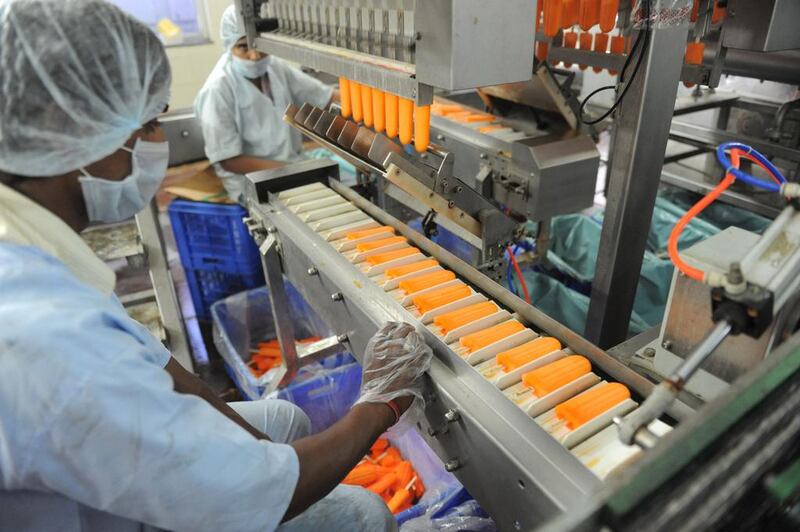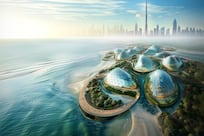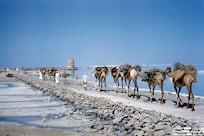India’s appetite for ice cream is on the rise.
Growing incomes, changing tastes and improving infrastructure are all helping to boost the growth of the ice cream industry.
“Essentially it’s to do with the changing demographics – the buyer is getting younger by the day, disposable incomes are also increasing as per capita income goes up, lifestyles are changing,” says Nitin Arora, the chief executive of Creambell, one of India’s big ice cream companies, headquartered in Gurgaon, north India. “There are so many factors in favour of ice cream. I’m very bullish.”
Mr Arora says there are about six major national brands and some 8,000 ice cream manufacturers, as well as multinational brands, in the country.
The ice cream industry in India generated revenue of more than US$1.5 billion last year and is expected to more than double to generate over $3.4bn by 2021, according to TechSci Research, a global market research and consulting company.
Figures from the consultancy Technopak show that the annual per capita ice cream consumption in India is 300ml, compared with 22,000ml (22 litres) in the US and 3,000ml (3 litres) in China, proving there is ample room for growth.
“Ice-cream earlier was considered as a luxury food product. However, with changing time taste and preference of consumers changed, which propelled growth in the India ice cream market over the past few years,” says Karan Chechi, the research director at TechSci. “Moreover, growing demand for natural and traditional flavoured ice cream, coupled with increasing penetration of international brands, improvement in cold chain infrastructure and rapid urbanisation are set to drive the India ice cream market during the forecast period.”
The most popular classic flavours are chocolate, vanilla, strawberry and mango, while more traditional Indian flavours such and kesar pista and pista kulfi are also highly popular, according to TechSci, a consumer market research advisory.
Amul, based in Anand in Gujarat, is the market leader in the ice cream sector, helped by the fact that it is the country’s largest producer of milk.
R S Sodhi, the managing director of Amul, says that the company has a 42 per cent share of the Indian market, with 120,000 ice cream stores, and with its products available across more than 2,000 towns in the country. Amul is aiming to double its sales volume in the next five years.
“Demand for ice cream in India is summer-driven, starting in March and lasts until the onset of monsoon in June. This peak season contributes more than 40 per cent of annual sales. The second mini-peak season of ice cream is after monsoon and before winter season, when there are lots of festivals and also temperature is moderately high.”
He added that Indian consumers are shifting from traditional sweets to ice creams in routine food habits, festivals, gifting, and celebrations such as weddings and birthday parties.
The Amul executive explains that competition in the industry is a challenge that is keeping the brand on its toes. But he says that the “multinationals are limited to big cities and niche products”.
“The next challenge for is to improve distribution depth, especially in the rural market where branded ice cream is still considered a niche product,” he adds.
Ankit Chona, the managing director of Havmor, another of India’s major ice cream producers, based in Gujarat, says he expects the industry to expand by 15 per cent annually “for at least the next five years” and sees “no reason why the market should not explode”.
“The ice cream industry is still at its nascent stages and still has a long way to go,” says Mr Chona.
A few years ago, power was the biggest challenge across villages and even cities in India, but this situation is improving, which has helped to facilitate the rapid growth of the ice cream sector, he says. The availability of more refrigeration facilities across the country is also helping.
In recent months, growth has slowed slightly because of the impact of the government’s demonetisation move in November, which led to a cash crunch following the removal of the country’s two highest value banknotes, he says.
The major “short-term challenge” for the sector, however, is the rise in the costs of ingredients.
Skimmed milk powder was priced at about 140 rupees per kilogram last year and now the market price is 240 rupees a kilogram. Other ingredients including sugar have also become more expensive.
“That’s the industry-wide challenge that everyone is facing right now, so there’s nothing left to do but to obviously increase prices,” says Mr Chona.
But there is a limit to how much prices can be raised.
“There has been a surge as far as the input costs are concerned in the last couple of months,” says Mr Arora of Creambell. “This leads to a situation where most of the brands end up absorbing the brunt of this and we are not able to pass on much to the consumer. It has most of us going back to the drawing [board] and trying to reconstruct the cost model.”
Creambell’s costs this year have increased by about 25 per cent and it has raised prices by 7.5 per cent, he says.
Another challenge that the sector faces is the competition between the organised big brands and the unorganised small-scale ice cream vendors.
“Anybody with a start up capital of 25 lakh rupees [Dh137,000] can start a small ice cream plant,” says Mr Chona of Havmor.
He says that some of these smaller players do not adhere to the health and safety standards and do not pay taxes “and are too small to come under the radar of the government”, meaning that they can undercut the bigger brands in the pricing of their ice creams.
“It’s just not a level playing field”.
Despite the increased presence of multinationals, including the likes of Baskin Robbins, Mr Chona says there is room for branded companies to exist alongside each other and for everyone to grow.
“What happens is as multinationals come in they advertise significantly and that creates consumer awareness and that also helps us,” says Mr Chona. “They advertise a disproportionate amount to their revenues because they have deep pockets, so the overall ice cream market benefits.”
Shivkant Sidnal, the managing director of Adityaa, a relatively new Karnataka-based ice cream company that launched in 2008, says: “With the advent of multinational and national companies mushrooming in the ice cream industry, the competition level in India has gone very high.”
But consumption is also rapidly growing and Indians are increasingly looking for new flavours, he says.
“There is a radical change in the thinking of Indian consumers. Today the consumers are looking for more flavours, variety and range.”
The Ice Cream Factory, which has an outlet in Mumbai, aims to deliver a “live” ice cream experience to its customers by preparing rolled ice cream in front of them and using liquid nitrogen for theatrical effect, with its flavours including “smoking biscuits” and “dragon breath poppers”.
Owais Merchant, the managing director, says he saw “a gap in the market” and that his long-term plan is to expand the brand across the country.
“Companies like Amul, Mother Dairy, Vadilal, Havmor, have been in the industry for a very long time, which has made them able to garner trust and loyalty amongst consumers,” says Laltu Sinha, a research manager at TechSci. “Foreign players entering the market are expected to face tough competition due to the high cost of raw materials, scarce presence in the country, and due to high loyalty of the consumers towards existing brands”
Despite the improvement in refrigeration facilities, this still poses a problem in parts of India.
“Supply chain management is another challenge in the Indian ice cream market,” says Mr Sinha. “The companies looking to expand into rural areas have to deal with the lack of cold storage and transportation facilities, which is not as advanced when compared to other countries.”
business@thenational.ae
Follow The National's Business section on Twitter





